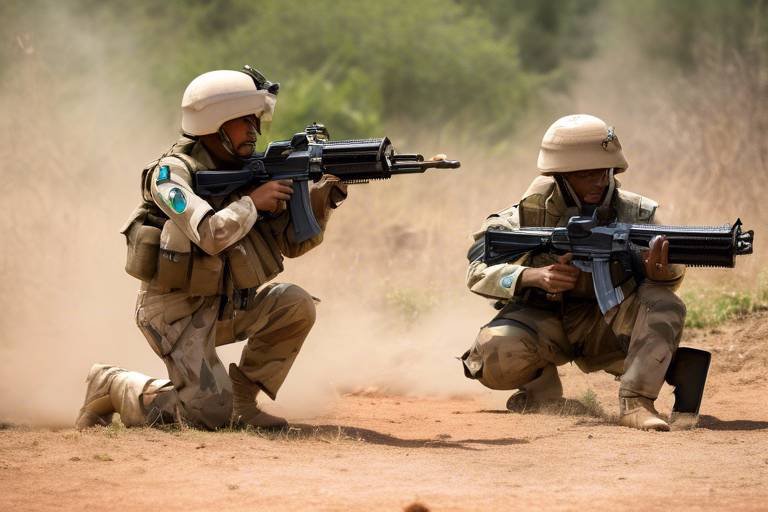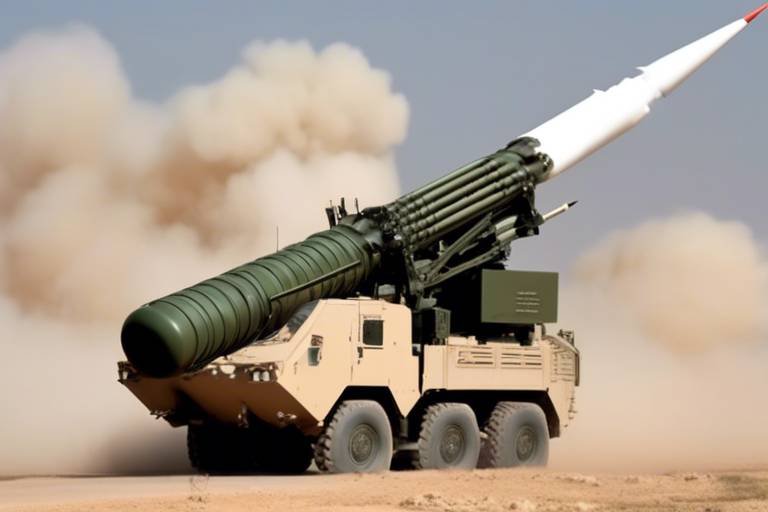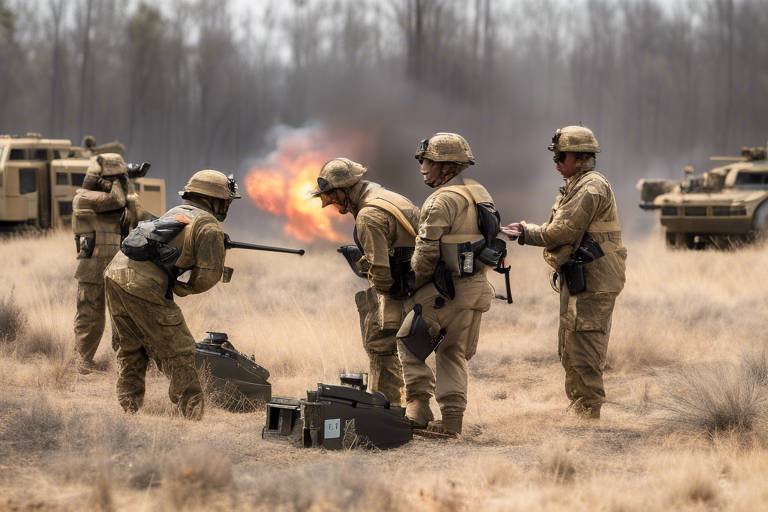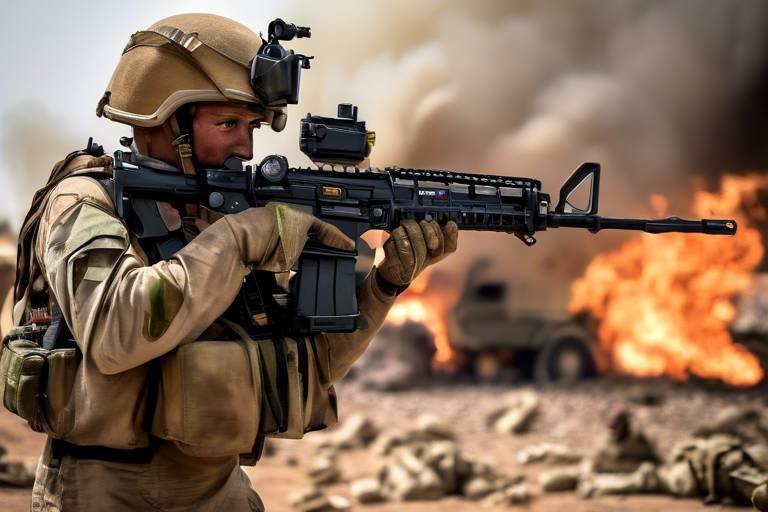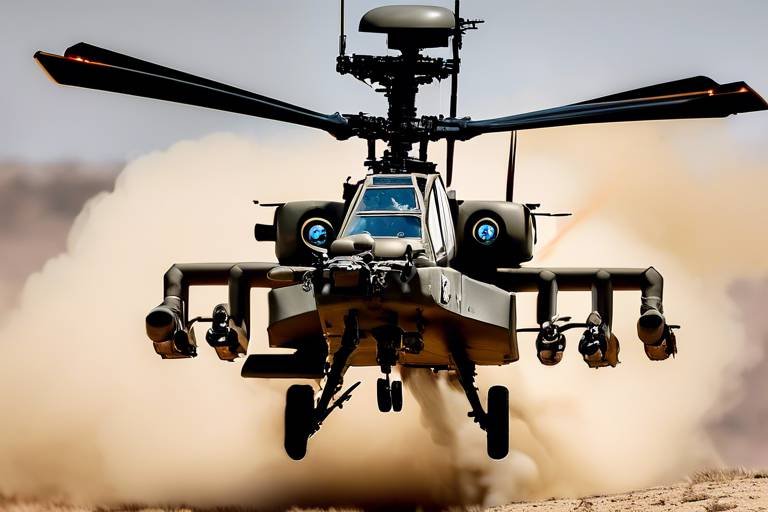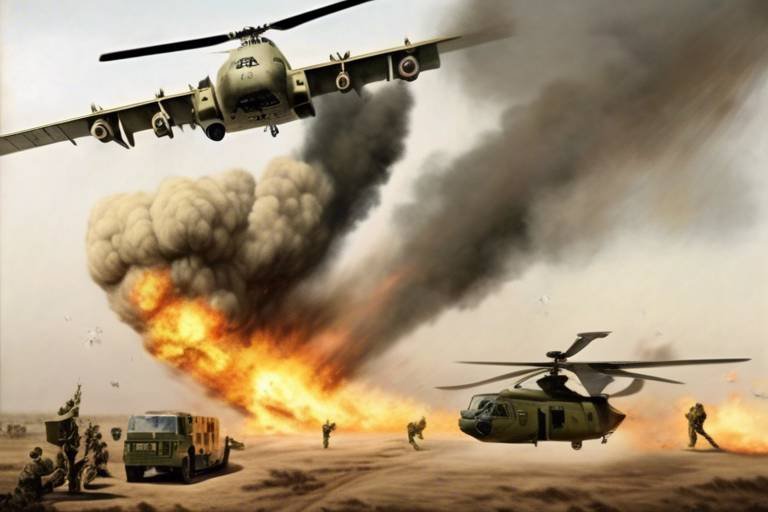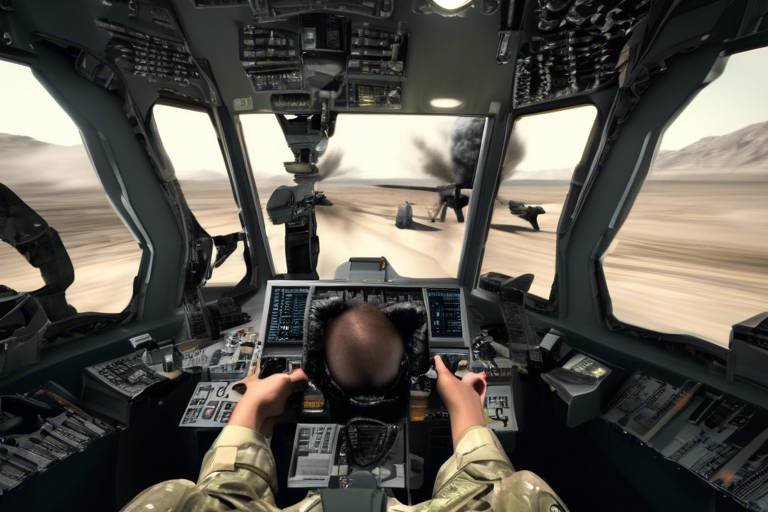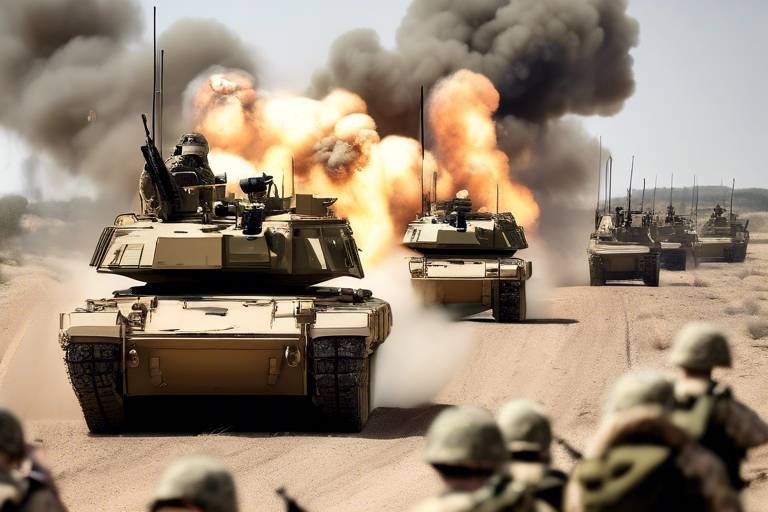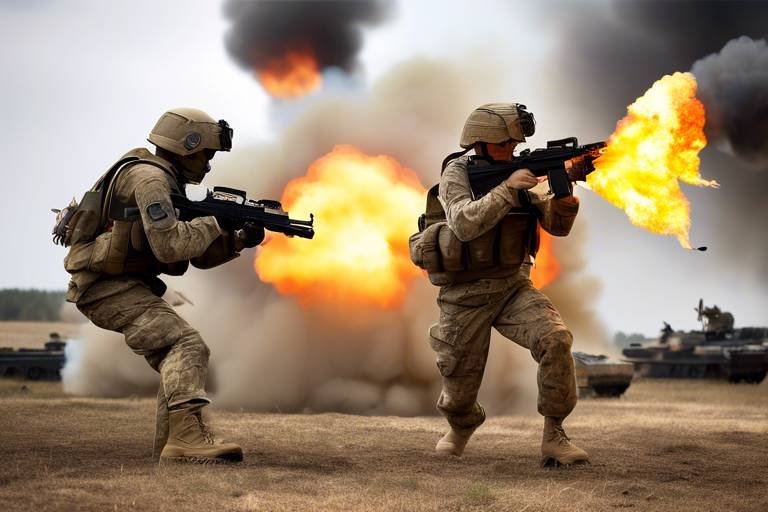Understanding the Use of Firepower in Peacekeeping Missions
In today's world, where conflicts can erupt at any moment, the role of peacekeeping missions has never been more critical. These operations are not just about wearing blue helmets and waving flags; they involve complex strategies that often require the use of firepower. But what does that really mean? This article dives deep into the intricacies of utilizing firepower in peacekeeping missions, exploring its necessity, effectiveness, and the ethical dilemmas that come with it. Imagine being a peacekeeper in a war-torn area, where your presence is the only barrier between chaos and order. The weight of responsibility is immense, and the tools at your disposal can make all the difference.
Firepower serves as a crucial tool in peacekeeping missions, acting as a deterrent to aggression and a shield for civilians caught in the crossfire. Think of it as a double-edged sword; while it can protect, it can also escalate tensions if not used judiciously. In many cases, the mere presence of armed peacekeepers can dissuade potential aggressors from acting violently. For instance, when peacekeepers are equipped with military-grade weapons, they send a strong message that they are prepared to respond to threats. However, the integration of firepower into peacekeeping strategies is not a straightforward affair. It requires a careful assessment of the local context, the nature of the conflict, and the objectives of the mission.
To truly understand the use of firepower in peacekeeping, we must look back at historical missions. Over the decades, the role of firepower has evolved significantly. In the early days of peacekeeping, the focus was primarily on unarmed observers and diplomatic negotiations. However, as conflicts became more complex and violent, the need for a more robust approach became evident. Notable cases, such as the United Nations' operations in Somalia and Rwanda, highlighted the limitations of traditional peacekeeping methods and paved the way for a new era where firepower became an integral part of the strategy.
The United Nations' intervention in Bosnia during the 1990s is a poignant example of the complexities surrounding the use of firepower in peacekeeping. Initially, UN forces were deployed with the intention of maintaining peace through diplomatic means. However, as violence escalated, peacekeepers found themselves in increasingly dangerous situations. The decision to use firepower became a contentious issue, raising questions about the effectiveness of the mission and the safety of both peacekeepers and local civilians. The consequences of these decisions continue to resonate today, reminding us of the thin line between peacekeeping and active combat.
The Bosnia mission offers valuable insights into the delicate balance between force and diplomacy. One key takeaway is that the use of firepower must be accompanied by clear objectives and a comprehensive understanding of the conflict. Peacekeepers must be equipped not only with weapons but also with the skills to engage in dialogue and negotiation. This balance is crucial, as the misuse of firepower can lead to unintended consequences, including civilian casualties and further destabilization of the region. The lessons learned from Bosnia serve as a guiding light for future peacekeeping operations.
Understanding the experiences from the Bosnia mission informs current peacekeeping strategies significantly. Today, peacekeeping forces are often tasked with multifaceted roles that go beyond mere military presence. They are expected to engage in community building, support humanitarian efforts, and foster dialogue among conflicting parties. The lessons from the past emphasize the importance of integrating firepower with diplomatic initiatives, ensuring that peacekeepers can respond effectively to threats while still promoting long-term stability.
The use of firepower in peacekeeping raises significant ethical questions. Peacekeepers often find themselves in morally ambiguous situations where the decision to use force can have profound implications. For instance, how do you protect civilians without escalating violence? The ethical dilemmas faced by peacekeepers are not just about adhering to rules of engagement; they involve deep moral considerations regarding the sanctity of life and the responsibility to protect. These dilemmas require peacekeepers to navigate a complex landscape of rights and wrongs, often with little time to deliberate.
Effective peacekeeping requires a delicate balance between using firepower and engaging in diplomatic efforts. Achieving this balance is no easy feat; it demands a nuanced understanding of the local dynamics and the ability to adapt strategies accordingly. Peacekeepers must be trained not only in combat but also in negotiation and conflict resolution. This duality is essential for maintaining mission integrity and effectiveness. In many cases, the best approach is to use firepower as a last resort, ensuring that diplomatic channels are exhausted before resorting to force.
Collaboration among various stakeholders enhances peacekeeping effectiveness. By working together with local governments, NGOs, and community leaders, peacekeepers can create a more sustainable peace without relying solely on firepower. This collaborative approach fosters trust and understanding, reducing the need for military intervention. When peacekeepers engage with the community, they can better assess the situation on the ground and tailor their strategies to meet the needs of the people they are sworn to protect.
As global conflicts evolve, so too does the approach to firepower in peacekeeping. Future trends may include advanced technology, such as drones and surveillance systems, which can provide critical intelligence without direct confrontation. Additionally, there is a growing emphasis on non-lethal methods of engagement, allowing peacekeepers to maintain order without resorting to violence. These innovations may reshape the landscape of peacekeeping, making it possible to achieve objectives while minimizing the risks associated with firepower.
- What is the primary purpose of firepower in peacekeeping missions?
Firepower is used primarily to deter aggression and protect civilians in conflict zones. - How has the role of firepower in peacekeeping evolved over time?
Initially focused on unarmed observation, the role of firepower has expanded to include military engagement as conflicts have become more violent. - What are the ethical considerations regarding the use of firepower?
The ethical dilemmas include the potential for civilian casualties and the moral implications of using force in volatile situations. - How can peacekeepers balance the use of firepower and diplomacy?
Effective peacekeeping requires integrating military readiness with diplomatic efforts, ensuring that force is a last resort.
The Role of Firepower in Peacekeeping
Firepower plays a pivotal role in peacekeeping missions, acting as both a deterrent against aggression and a means of protecting vulnerable civilian populations. In conflict zones, the mere presence of armed forces can often discourage hostile actions and promote a sense of security among the local populace. However, the integration of firepower into peacekeeping strategies is not a straightforward task; it involves a complex interplay of military might, diplomacy, and ethical considerations. This delicate balancing act is essential in ensuring that peacekeeping missions achieve their objectives without escalating violence or undermining the very peace they aim to uphold.
One of the primary functions of firepower in peacekeeping is to prevent violence. By showcasing military capabilities, peacekeeping forces can deter potential aggressors from committing acts of violence against civilians or opposing factions. This deterrent effect is particularly crucial in volatile regions where the threat of conflict looms large. For example, during the early stages of a mission, the deployment of heavy weaponry can signal a firm commitment to maintaining order, thereby reducing the likelihood of confrontations. However, it is essential to recognize that the use of firepower must be tempered with restraint; excessive force can lead to unintended consequences, including civilian casualties and loss of credibility.
Moreover, the effectiveness of firepower in peacekeeping is often contingent upon the context of the mission. Each conflict zone presents unique challenges that require tailored approaches. In some cases, a show of force may be necessary to stabilize a situation, while in others, a more diplomatic approach may yield better results. For instance, in regions where local factions are deeply entrenched, a heavy-handed military presence might exacerbate tensions rather than alleviate them. Therefore, peacekeeping forces must be equipped with a range of tools—not just firepower—to navigate these complexities effectively.
In addition to deterrence, firepower is also crucial for protecting civilians during peacekeeping operations. When armed groups threaten innocent lives, peacekeepers may need to resort to force to safeguard those at risk. This protection can manifest in various forms, from direct engagement with hostile forces to establishing safe zones for displaced individuals. The decision to use firepower in these instances is often fraught with moral dilemmas, as peacekeepers must weigh the immediate need for action against the potential for long-term repercussions.
Ultimately, the role of firepower in peacekeeping is about striking a balance. It is not merely about the use of weapons but rather about the strategic application of military force in conjunction with diplomatic efforts. Peacekeeping missions must prioritize dialogue and negotiation, using firepower as a last resort. The goal should always be to foster an environment where peace can flourish, free from the shadow of violence.
- What is the primary purpose of firepower in peacekeeping?
Firepower serves as a deterrent against aggression and a means to protect civilians in conflict zones. - How does the context of a mission affect the use of firepower?
Different conflict zones present unique challenges, requiring peacekeepers to adapt their strategies, balancing military force with diplomatic efforts. - What ethical considerations come into play with the use of firepower?
Peacekeepers must consider the potential for civilian casualties and long-term consequences when deciding to employ force. - Can firepower be used effectively without escalating violence?
Yes, when used strategically and in conjunction with diplomatic efforts, firepower can help stabilize situations without escalating violence.
Historical Context of Firepower in Peacekeeping
When we think about peacekeeping, the first image that often comes to mind is that of soldiers in blue helmets, standing as a symbol of hope amid chaos. However, the historical context of firepower in peacekeeping reveals a more complicated narrative. Over the decades, peacekeeping missions have undergone significant transformations, particularly in their approach to the use of force. Initially, peacekeeping forces were largely unarmed, focusing on observation and reporting. But as conflicts grew more intense and complex, the necessity for firepower became evident.
Take, for instance, the peacekeeping operations in the 1990s. The United Nations deployed troops to various conflict zones, but the lack of adequate firepower often left them vulnerable. The tragic events in Rwanda and the Balkans highlighted the consequences of under-equipped peacekeepers. In Rwanda, the inability to intervene decisively during the genocide led to a reevaluation of how peacekeepers should operate in hostile environments. This was a wake-up call, emphasizing that sometimes, a show of force is necessary to deter aggression and protect civilians.
Throughout history, several key missions have shaped the understanding of firepower in peacekeeping. For example, the UN's intervention in Somalia during the early 1990s marked a turning point. Initially, the mission aimed to provide humanitarian aid, but escalating violence forced peacekeepers to engage more robustly. The infamous "Black Hawk Down" incident in 1993 underscored the dangers of peacekeeping in active conflict zones and sparked debates about the appropriate use of military force.
To better understand the evolution of firepower in peacekeeping, we can look at a few pivotal cases:
- UNPROFOR in Bosnia (1992-1995): This mission is often cited as a critical example where the use of firepower was necessary to protect civilians and maintain some semblance of order.
- Operation Restore Hope in Somalia (1992): Initially focused on humanitarian aid, the mission escalated into a combat situation, demonstrating the need for a more aggressive approach.
- UNAMID in Darfur (2007-present): This mission highlights the ongoing challenges of balancing firepower with humanitarian objectives in a complex conflict environment.
As we analyze these historical contexts, it becomes clear that the use of firepower in peacekeeping is not merely a tactical decision; it carries significant implications for the mission's legitimacy and success. The balance between force and diplomacy remains a delicate dance, one that peacekeepers must navigate with care. The lessons learned from these historical missions continue to inform current strategies, reminding us that while the ultimate goal is to maintain peace, sometimes the path to that peace requires a firm hand.
In conclusion, the historical context of firepower in peacekeeping is a testament to the evolving nature of conflict resolution. Understanding this evolution helps us appreciate the complexities involved in modern peacekeeping efforts, where the use of force is often seen as both a necessary evil and a last resort.
- What is the primary purpose of firepower in peacekeeping missions?
Firepower is primarily used to deter aggression, protect civilians, and ensure the safety of peacekeepers in volatile environments. - How has the approach to firepower in peacekeeping changed over the years?
Initially focused on unarmed observation, the approach has evolved to include more robust military capabilities in response to escalating violence in conflict zones. - What are some key historical peacekeeping missions that utilized firepower?
Notable missions include UNPROFOR in Bosnia, Operation Restore Hope in Somalia, and UNAMID in Darfur.
Case Study: The UN in Bosnia
The United Nations' intervention in Bosnia during the 1990s stands as a compelling case study in the complexities surrounding the use of firepower in peacekeeping missions. Following the breakup of Yugoslavia, Bosnia and Herzegovina plunged into a brutal conflict characterized by ethnic violence, leading to a humanitarian crisis that demanded international attention. The UN's response included the deployment of peacekeeping forces, but the mission was fraught with challenges, particularly regarding the rules of engagement and the extent to which firepower could be utilized.
Initially, the UN peacekeepers, known as UNPROFOR, were tasked with monitoring ceasefires and providing humanitarian aid. However, as the conflict escalated, it became increasingly clear that mere presence was insufficient to deter aggressors. The infamous Srebrenica massacre in 1995, where over 8,000 Bosniak men and boys were killed, highlighted the limitations of the UN's mandate and the dire consequences of inaction. This tragic event raised urgent questions about the effectiveness of peacekeeping missions that lack the authority to use force when necessary.
In response to the growing violence and the failure to protect civilians, the international community began to reconsider the role of firepower in peacekeeping. The UN eventually authorized airstrikes against Bosnian Serb forces, marking a significant shift in strategy. This decision underscored a critical lesson: the integration of firepower into peacekeeping operations can be essential for protecting vulnerable populations and restoring peace. However, it also raised ethical dilemmas about the use of force and the potential for collateral damage.
To better understand the implications of firepower in this context, we can examine key factors that influenced the UN's decisions during the Bosnia mission:
| Factor | Description |
|---|---|
| Humanitarian Crisis | The ongoing ethnic cleansing and mass atrocities necessitated a stronger response. |
| International Pressure | Global outrage over the violence, especially after Srebrenica, pushed for a more robust intervention. |
| Rules of Engagement | Initial restrictions limited the use of force, complicating peacekeepers' ability to act decisively. |
| Political Dynamics | Geopolitical considerations influenced the extent and nature of military involvement. |
Ultimately, the UN's experience in Bosnia illustrates the delicate balance between maintaining peace and employing firepower. While the use of force can be justified in protecting civilians and restoring order, it also necessitates careful consideration of the potential consequences. The lessons learned from Bosnia continue to inform contemporary peacekeeping strategies, emphasizing the need for flexibility in response to evolving threats while adhering to ethical standards.
Lessons Learned from Bosnia
The United Nations peacekeeping mission in Bosnia during the 1990s serves as a profound case study for understanding the intricate dynamics of using firepower in peacekeeping operations. One of the most significant lessons drawn from this mission is the realization that while firepower can deter aggression, its application must be meticulously balanced with diplomatic efforts. In Bosnia, the initial reluctance to use force resulted in catastrophic consequences for civilians caught in the crossfire of ethnic conflict. This highlighted the necessity for peacekeepers to have a clear mandate that includes the potential for forceful intervention when civilian lives are at stake.
Furthermore, the Bosnia mission illustrated the importance of intelligence and situational awareness in the deployment of firepower. Peacekeepers often found themselves in precarious positions, lacking the necessary information to make informed decisions. This gap in intelligence not only endangered their safety but also complicated the mission's objectives. Therefore, a robust intelligence framework is essential for modern peacekeeping forces to ensure that firepower is employed effectively and judiciously.
Another critical lesson learned is the need for comprehensive training for peacekeepers regarding the use of force. In Bosnia, many peacekeepers were unprepared for the realities of armed conflict, leading to hesitancy and confusion during critical moments. Training programs must encompass not only tactical skills but also ethical considerations and conflict resolution strategies. This holistic approach equips peacekeepers to make sound decisions that prioritize human rights and the protection of civilians.
Moreover, the Bosnia experience underscores the significance of collaboration with local communities. Engaging with local populations can provide invaluable insights that help peacekeepers navigate complex social dynamics. When peacekeepers build trust and foster relationships with community leaders, they can enhance their operational effectiveness and reduce the perceived need for firepower. This collaborative approach also aids in creating a sustainable peace, as it empowers local actors to take ownership of their security.
Finally, the Bosnia mission serves as a reminder of the potential long-term repercussions associated with the use of firepower. While immediate threats may necessitate a show of force, peacekeepers must remain cognizant of how their actions can affect the broader peace process. Decisions made in the heat of the moment can lead to lasting tensions and undermine efforts toward reconciliation. Thus, maintaining a focus on long-term peacebuilding goals is essential, even in the face of immediate challenges.
- What was the main goal of the UN peacekeeping mission in Bosnia?
The primary goal was to maintain peace and security amid the violent conflicts resulting from the breakup of Yugoslavia, particularly to protect civilians and facilitate humanitarian aid. - How did the use of firepower impact the mission's effectiveness?
Firepower, when used judiciously, helped deter aggressors and protect civilians. However, misuse or hesitancy in its application often led to severe consequences for the mission and local populations. - What lessons can current peacekeeping missions learn from Bosnia?
Current missions can learn the importance of a clear mandate, robust training, intelligence gathering, community engagement, and a focus on long-term peacebuilding to balance the use of firepower with diplomacy.
Implications for Current Missions
The lessons learned from the Bosnia mission have profound implications for current peacekeeping operations around the globe. As we navigate through contemporary conflicts, the necessity of integrating firepower into peacekeeping strategies cannot be understated. However, the challenge lies in understanding when and how to effectively use this firepower without compromising the mission’s integrity or the safety of civilians. The Bosnia case exemplifies that while firepower can deter aggression, it can also escalate tensions if not applied judiciously. Therefore, current missions must prioritize a nuanced approach that balances the use of force with diplomatic engagement.
One of the key implications is the need for comprehensive training for peacekeepers. Modern peacekeeping forces must be equipped not only with the tactical skills necessary for the effective use of firepower but also with the diplomatic skills to engage with local communities. This dual training ensures that peacekeepers can navigate complex environments where the line between peacekeeping and combat can often blur. For instance, peacekeepers must be adept at assessing situations in real-time, making split-second decisions that weigh the potential consequences of using force against the need to protect civilians.
Moreover, the role of technology in peacekeeping cannot be overlooked. Advances in surveillance and communication technology provide peacekeepers with enhanced situational awareness, allowing them to make informed decisions regarding the use of firepower. For example, unmanned aerial vehicles (UAVs) can monitor conflict zones, providing real-time data that informs whether a show of force is necessary or if a more diplomatic approach can be taken. This shift towards technology-driven strategies represents a significant evolution in how peacekeeping missions operate.
Additionally, the importance of collaboration with local actors and international organizations is paramount. Current missions must engage with local communities to foster trust and understanding, which can significantly reduce the reliance on firepower. By establishing partnerships with local leaders and organizations, peacekeepers can promote dialogue and reconciliation, creating an environment where the need for force diminishes. This collaborative approach not only enhances the effectiveness of peacekeeping efforts but also contributes to long-term stability in conflict-affected regions.
In summary, the implications of the Bosnia mission for current peacekeeping operations underscore the necessity of a balanced approach. By integrating comprehensive training, leveraging technology, and fostering collaboration, peacekeeping missions can navigate the complexities of modern conflicts more effectively. The ultimate goal remains clear: to maintain peace and security while respecting the rights and dignity of all individuals involved.
- What is the primary role of firepower in peacekeeping missions?
Firepower serves as a deterrent against aggression and helps protect civilians in conflict zones. Its use must be carefully considered to avoid escalating violence. - How can peacekeepers balance the use of force with diplomacy?
Peacekeepers can achieve balance through comprehensive training that equips them with both tactical and diplomatic skills, enabling them to assess situations and respond appropriately. - Why is technology important in modern peacekeeping?
Technology enhances situational awareness, allowing peacekeepers to make informed decisions regarding the use of firepower and improving overall mission effectiveness. - What role do local communities play in peacekeeping?
Engaging with local communities fosters trust and understanding, which can reduce the reliance on firepower and promote sustainable peace.
Ethical Considerations of Firepower Use
The deployment of firepower in peacekeeping missions is not just a matter of strategy; it brings forth a plethora of ethical dilemmas that challenge the very essence of humanitarian intervention. When peacekeepers are faced with the decision to use force, they must weigh the potential benefits against the potential harm. This balancing act is akin to walking a tightrope, where every misstep can lead to disastrous consequences for both the mission and the local populace. The question arises: how do peacekeepers justify the use of firepower in scenarios where it could lead to civilian casualties?
One critical aspect of this ethical debate revolves around the principle of proportionality. According to international law, any use of force must be proportionate to the threat faced. This means that peacekeepers must carefully assess whether the firepower they are considering deploying is necessary to achieve their objectives. For instance, if a peacekeeping force is confronted by armed militants, the immediate instinct may be to respond with overwhelming force. However, this response could escalate violence, leading to unintended consequences such as civilian casualties or further destabilization of the region.
Moreover, the accountability of peacekeepers is a significant concern. Who is responsible when firepower leads to tragic outcomes? Is it the individual peacekeeper, the commanding officers, or the broader international community? This ambiguity can create an environment of impunity, where peacekeepers may feel emboldened to use force without fully considering the ramifications. The lack of clear accountability can undermine the legitimacy of peacekeeping missions and erode trust among local populations, which is essential for long-term peace.
Additionally, the ethical implications extend beyond immediate consequences. The long-term impact on local communities must also be considered. The use of firepower can create a cycle of violence that is difficult to break. When civilians perceive peacekeepers as aggressors rather than protectors, it can lead to resentment and resistance against international efforts to maintain peace. This situation is reminiscent of a gardener who, in an attempt to prune a tree, inadvertently damages its roots. The tree may survive, but its growth will be stunted, and its ability to flourish will be compromised.
In navigating these ethical waters, peacekeepers must adhere to a framework of guiding principles that prioritize the protection of civilians and the promotion of peace. These principles include:
- Minimizing Harm: Always seek to minimize harm to civilians and infrastructure.
- Engagement and Dialogue: Prioritize diplomatic solutions and dialogue before resorting to force.
- Transparency: Maintain transparency with local communities about the use of force and the reasons behind it.
- Training and Guidelines: Ensure that peacekeepers are adequately trained in the ethical implications of using firepower.
Ultimately, the ethical considerations surrounding the use of firepower in peacekeeping missions are complex and multifaceted. It requires a careful analysis of each situation, a commitment to humanitarian principles, and a willingness to learn from past mistakes. As peacekeeping evolves, so too must the ethical frameworks that guide these critical decisions, ensuring that the primary goal remains the protection and well-being of those caught in the crossfire of conflict.
Q: What are the primary ethical concerns regarding the use of firepower in peacekeeping?
A: The primary ethical concerns include the principle of proportionality, accountability for actions taken, and the long-term impact on local communities.
Q: How can peacekeepers ensure they are using firepower ethically?
A: Peacekeepers can ensure ethical use by adhering to guiding principles such as minimizing harm, prioritizing dialogue, and maintaining transparency with local populations.
Q: What role does international law play in the use of firepower in peacekeeping?
A: International law provides a framework for the use of force, emphasizing the need for proportionality and the protection of civilians during peacekeeping operations.
Balancing Force and Diplomacy
In the intricate world of peacekeeping, striking a balance between force and diplomacy is not just a strategy; it’s an art form. Imagine a tightrope walker, carefully navigating between two extremes: on one side, the overwhelming power of military might, and on the other, the gentle yet firm touch of diplomatic dialogue. In peacekeeping operations, this balance is essential for achieving lasting stability in conflict-ridden regions. The presence of armed forces can deter aggression and provide safety to vulnerable populations, yet it can also escalate tensions if not wielded judiciously. So, how do peacekeepers manage this delicate dance?
One key approach is the integration of robust rules of engagement that clearly define when and how force can be applied. These rules serve as a guiding framework for peacekeepers, ensuring that any use of firepower is both necessary and proportionate to the threat faced. For instance, in volatile situations where civilians are at risk, peacekeepers may need to demonstrate a readiness to use force. However, this should always be coupled with ongoing diplomatic efforts to resolve conflicts peacefully. After all, the ultimate goal of peacekeeping is not merely to maintain order through force but to foster an environment where dialogue can flourish.
Furthermore, effective communication plays a crucial role in this balancing act. Peacekeepers must engage with local communities, understanding their concerns and aspirations. By building trust and rapport, they can often mitigate the need for force altogether. In fact, many successful peacekeeping missions have relied heavily on community engagement as a primary tool for maintaining peace. This proactive approach can lead to a situation where diplomacy prevails, reducing the likelihood of violent confrontations.
To illustrate this balance, consider the following table that outlines the relationship between the use of force and diplomatic efforts in peacekeeping missions:
| Scenario | Use of Force | Diplomatic Efforts |
|---|---|---|
| High Tension with Imminent Threat | Deploy military assets to deter aggression | Simultaneously engage in negotiations with conflicting parties |
| Civilian Protection Required | Utilize force to secure vulnerable populations | Work with local leaders to establish safe zones |
| Post-Conflict Reconstruction | Minimal use of force, focus on security | Intensive diplomatic initiatives for rebuilding trust |
As we look to the future, the importance of balancing force and diplomacy in peacekeeping missions cannot be overstated. The dynamic nature of global conflicts means that peacekeepers must remain adaptable, ready to switch tactics as situations evolve. This adaptability requires not only military training but also a deep understanding of cultural contexts and the political landscape of the regions in which they operate. Peacekeepers who can navigate these complexities, leveraging both force and diplomacy, will be better equipped to achieve sustainable peace.
- What is the primary goal of peacekeeping missions? The primary goal is to maintain peace and security in conflict zones while protecting civilians and fostering conditions for lasting peace.
- How do peacekeepers decide when to use force? Peacekeepers rely on established rules of engagement, assessing the threat level and ensuring that any use of force is necessary and proportionate.
- Can diplomacy succeed without the presence of force? While diplomacy can be effective on its own, the presence of a capable force can enhance the credibility of diplomatic efforts, especially in high-tension scenarios.
- What role does community engagement play in peacekeeping? Engaging with local communities builds trust and understanding, which can help prevent violence and promote a peaceful resolution to conflicts.
Collaborative Approaches to Peacekeeping
In the realm of peacekeeping, the phrase “two heads are better than one” rings particularly true. Collaborative approaches to peacekeeping are essential for enhancing the effectiveness of operations in conflict zones. By fostering partnerships among various stakeholders—including international organizations, non-governmental organizations (NGOs), local governments, and community leaders—peacekeeping missions can amplify their impact while minimizing the need for firepower. Imagine a symphony orchestra: each musician plays a unique role, but it’s the harmony of their collaboration that creates beautiful music. Similarly, collaborative peacekeeping efforts can lead to sustainable peace and stability.
One of the primary benefits of collaboration is the pooling of resources and expertise. For instance, NGOs often have deep-rooted connections within local communities, allowing them to understand the cultural and social dynamics that affect peacekeeping efforts. This knowledge can be invaluable for military peacekeepers who may lack the same level of familiarity with the local context. By working together, these groups can devise strategies that are not only effective but also culturally sensitive, reducing the risk of misunderstandings and hostility.
Moreover, collaboration can help in the identification of potential threats before they escalate into violence. For example, community leaders can act as early warning systems, alerting peacekeepers to rising tensions or grievances that may lead to conflict. This proactive approach allows peacekeeping forces to engage in dialogue and mediation rather than resorting to force. In essence, the more eyes on the ground, the better prepared peacekeepers are to address issues before they spiral out of control.
Additionally, collaborative approaches can also enhance the legitimacy of peacekeeping missions. When local communities see their leaders and organizations actively involved in the peacekeeping process, they are more likely to support the mission. This local buy-in is crucial, as it fosters trust and cooperation between peacekeepers and the communities they serve. In many cases, the presence of peacekeepers can be met with skepticism or even hostility, but a collaborative framework can help bridge this gap.
However, achieving effective collaboration is not without its challenges. Different stakeholders may have differing priorities, agendas, and operational methods, which can lead to friction. To mitigate these issues, clear communication and a shared vision are vital. Establishing a common goal can unify diverse groups toward a single purpose, making it easier to navigate the complexities of peacekeeping.
In conclusion, collaborative approaches to peacekeeping are not just beneficial; they are essential for the success of missions in today's multifaceted conflict landscape. By harnessing the strengths of various stakeholders, peacekeepers can create a more resilient and effective response to violence and instability. As we look to the future, the importance of collaboration will only continue to grow, shaping the way we approach peacekeeping in an ever-changing world.
- What is the main goal of collaborative peacekeeping? Collaborative peacekeeping aims to enhance the effectiveness of missions by pooling resources, expertise, and local knowledge to create sustainable peace.
- How do NGOs contribute to peacekeeping efforts? NGOs often have strong ties to local communities, providing valuable insights into cultural dynamics and helping to mediate conflicts.
- What challenges do collaborative approaches face? Different priorities and operational methods among stakeholders can create friction, making clear communication and a shared vision essential for success.
- Why is local buy-in important for peacekeeping missions? Local buy-in fosters trust and cooperation, making it more likely that communities will support peacekeeping efforts and work alongside peacekeepers.
Future Trends in Peacekeeping Firepower
As we look towards the horizon of peacekeeping operations, it's crucial to recognize that the landscape of global conflict is constantly evolving. This evolution necessitates a corresponding shift in the strategies employed by peacekeeping forces, particularly regarding the use of firepower. The future of peacekeeping firepower is likely to be shaped by several key trends that reflect both technological advancements and changing geopolitical dynamics.
One of the most significant trends is the integration of advanced technology into peacekeeping missions. Unmanned aerial vehicles (UAVs), commonly known as drones, are becoming indispensable tools for surveillance and reconnaissance. These high-tech devices allow peacekeepers to monitor conflict zones without putting personnel at risk, offering a safer alternative to traditional methods. Moreover, drones can provide real-time intelligence, enabling peacekeeping forces to respond swiftly and effectively to emerging threats.
Additionally, the use of non-lethal weapons is gaining traction as peacekeeping missions strive to minimize casualties while maintaining order. Tools such as rubber bullets, stun grenades, and tear gas can help de-escalate violent situations without resorting to lethal force. This shift towards non-lethal options reflects an increasing recognition of the need to protect civilians and reduce the potential for collateral damage. However, the challenge remains to ensure that these non-lethal measures are used judiciously and do not inadvertently escalate tensions.
Furthermore, there is a growing emphasis on multinational collaboration in peacekeeping efforts, which can lead to more effective use of firepower. By pooling resources and expertise, nations can develop comprehensive strategies that leverage the strengths of each participant. This collaborative approach not only enhances operational effectiveness but also fosters a sense of shared responsibility among nations, which is vital for sustainable peace. For instance, joint training exercises can prepare peacekeepers to work together seamlessly, ensuring that firepower is used in a coordinated and ethical manner.
Another emerging trend is the increasing role of local actors in peacekeeping operations. Engaging local communities and stakeholders can significantly enhance the legitimacy and effectiveness of peacekeeping missions. By empowering local actors, peacekeepers can better understand the unique dynamics of the conflict and tailor their use of firepower accordingly. This localized approach can help mitigate the risks of misunderstanding and mistrust that often accompany external interventions.
Finally, the future of peacekeeping firepower will likely be influenced by ongoing discussions around ethical frameworks and accountability. As peacekeepers navigate the complexities of using force in volatile environments, there is a pressing need for clear guidelines that govern the use of firepower. Establishing robust accountability mechanisms can ensure that peacekeepers are held responsible for their actions, thereby fostering trust and credibility in their operations. This ethical dimension is crucial for maintaining the integrity of peacekeeping missions and ensuring that they remain focused on their primary goal: the protection of civilians and the restoration of peace.
In conclusion, the future of firepower in peacekeeping is poised for transformation. By embracing technological advancements, prioritizing non-lethal options, fostering multinational collaboration, engaging local actors, and adhering to ethical standards, peacekeeping missions can adapt to the challenges of modern conflict. As we move forward, it is essential to remain vigilant and proactive in our approach to firepower, ensuring that it serves as a tool for peace rather than a catalyst for further violence.
- What role does technology play in future peacekeeping operations? Technology, such as drones and advanced surveillance systems, enhances situational awareness and allows for safer monitoring of conflict zones.
- How are non-lethal weapons changing the approach to peacekeeping? Non-lethal weapons provide peacekeepers with options to manage conflicts without resorting to lethal force, thereby reducing civilian casualties.
- Why is collaboration among nations important in peacekeeping? Collaborative efforts enable nations to share resources and expertise, leading to more effective and coordinated peacekeeping strategies.
- What is the significance of engaging local actors in peacekeeping? Local actors provide valuable insights into the conflict dynamics, helping peacekeepers tailor their strategies and build trust within the community.
- How can ethical frameworks impact the use of firepower in peacekeeping? Clear ethical guidelines and accountability mechanisms are essential to ensure that the use of firepower is responsible and aligned with the mission's goals of protecting civilians and maintaining peace.
Frequently Asked Questions
- What is the primary role of firepower in peacekeeping missions?
Firepower plays a vital role in peacekeeping by deterring aggression and ensuring the safety of civilians. It acts as a protective measure that can help maintain order in conflict zones, allowing peacekeepers to carry out their missions effectively.
- How has the use of firepower in peacekeeping evolved over time?
The use of firepower in peacekeeping has evolved significantly, shaped by historical contexts and specific case studies, such as the UN's intervention in Bosnia. These experiences have informed current strategies, balancing the need for force with diplomatic efforts.
- Can you provide an example of a peacekeeping mission where firepower was crucial?
One notable example is the UN mission in Bosnia, where the use of firepower was essential to protect civilians and deter aggressors. The decisions made during this mission highlight the complexities and consequences of employing force in peacekeeping operations.
- What lessons were learned from the Bosnia mission regarding firepower?
The Bosnia mission taught valuable lessons about finding the right balance between using force and pursuing diplomatic solutions. It emphasized the importance of understanding the local context and the potential repercussions of military actions on peacekeeping efforts.
- What ethical dilemmas do peacekeepers face when using firepower?
Peacekeepers often grapple with significant ethical questions about when and how to use force. The moral implications of their decisions can impact not only the mission's success but also the safety and trust of local populations.
- How can peacekeeping missions balance the use of firepower with diplomacy?
Achieving a balance between firepower and diplomacy requires strategic planning and collaboration among various stakeholders. Engaging in dialogue and building partnerships can help mitigate the need for force while promoting sustainable peace.
- What are some future trends in the use of firepower in peacekeeping?
As global conflicts continue to evolve, future trends may include innovative approaches to firepower that emphasize technology and intelligence. This evolution could lead to more precise and effective use of force, minimizing collateral damage while enhancing mission outcomes.

